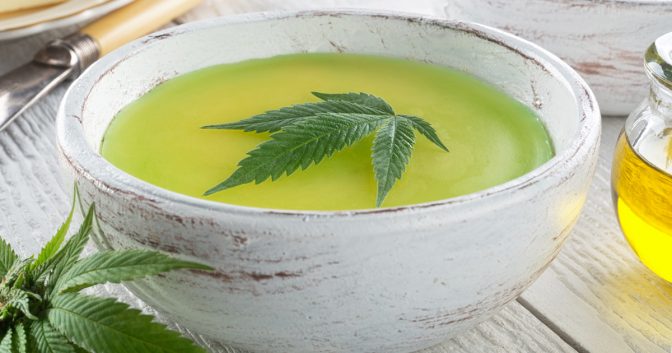How to Make Cannabis-Infused Butter and Oil

To make about 1 cup of cannabis-infused butter or oil, you will need:
• 1 1/4 cups unsalted butter or cooking oil of your choice
• 1 oz. average-to-high quality trim or low-quality dried bud; or 1/2 ounce average-quality dried bud
• About 4 cups water
Why Include Water as an Ingredient?
Water ensures the cannabis will never reach a higher temperature than the boiling point of 212 degrees F. Chlorophyll and terpenes—the parts of the plant that give it its flavor and color—are water-soluble. In practical terms, this means a lot of unwanted herbal flavor and green color can be flushed away with the water after cooking, instead of infusing them into the finished marijuana butter or oil. Using water won’t eliminate green color and herbal flavor, but it can reduce it. Without water in the mix, the plant material tends to absorb too much of the butter or oil. This means usable product is going into the trash, a problem that’s reduced or eliminated by adding water.
No Need to Grind
Forego the bad advice often seen on the Internet that tells you to grind plant material in a food processor or coffee grinder before using it to make butter or oil. Sticky THC-laden trichomes are on the plant, not in it. Ground plant material is more difficult to strain and gives the finished product an unwanted increased herbal flavor and darker green color.

Cannabis shake/flowers, butter and water in a slow cooker. (Photo by Mitch Mandell)
Slow Cooker Method
Add butter or oil, plant material and water to the slow cooker and cook on low heat for 6-8 hours.
Stovetop Method
Add butter or oil, plant material and water to a large lidded Dutch oven on the stovetop. Bring to a boil, reduce heat to very low and simmer for 6-8 hours. Take care to monitor the liquid level often, adding water as necessary in order to always keep at least 3 cups in the pot. Simmering marijuana on the stovetop is very aromatic: If you’re worried about nosy neighbors, cook other strong-smelling foods (such as garlic) at the same time. Better still, use a slow cooker.
Drain and Strain
The draining procedure is the same for both cooking methods. Place a cheesecloth-lined colander over a large pot or bowl, and pour the liquid through to strain. Before discarding the plant material, pour a large kettle full of boiling water over the full strainer in order to wash through any extra butter or oil clinging to it. Allow the plant material to cool, then squeeze out as much liquid as possible. Discard the plant material. Chill the water and oil, or water and liquid butter. The fats will rise to the top.
Butter solidifies when chilled, making it easy to simply lift the piece off and discard the water below. Oil will rise to the top of the water, but often won’t solidify. Use a spoon to skim the oil off the water. Even better, use a gravy separator (it looks like a small pitcher with the spout on the bottom). This unique design allows the water to be poured out while retaining every drop of the oil floating at the top.
Strain the butter or oil through cheesecloth a second time to remove as much sediment as possible (this step is optional). To strain butter, melt it, strain, then chill again until solid.

Several jars of Cheri’s cannabutter and oil. (Photo by Mitch Mandell
Storing Canna Butter and Oil
Refrigerate infused butter or oil until ready to use, or freeze it for even longer storage. Fats can still go rancid in the freezer, so try to use it within three months.
Now you’re ready to start cooking with canna-butter and canna-oil.
Related Articles
A Brief History of Edibles (excepted from The Easy Cookbook)
Five Marijuana Munchies: From Brownies to Potcorn
Food for Thought: Cannabis Cheri’s 420 Recipes
Cannabis Cheri’s Summer of Veg Recipes
Cannabis Cheri’s High Holidaze Pot Cookie Party
If you enjoyed this Freedom Leaf article, subscribe to the magazine today!

